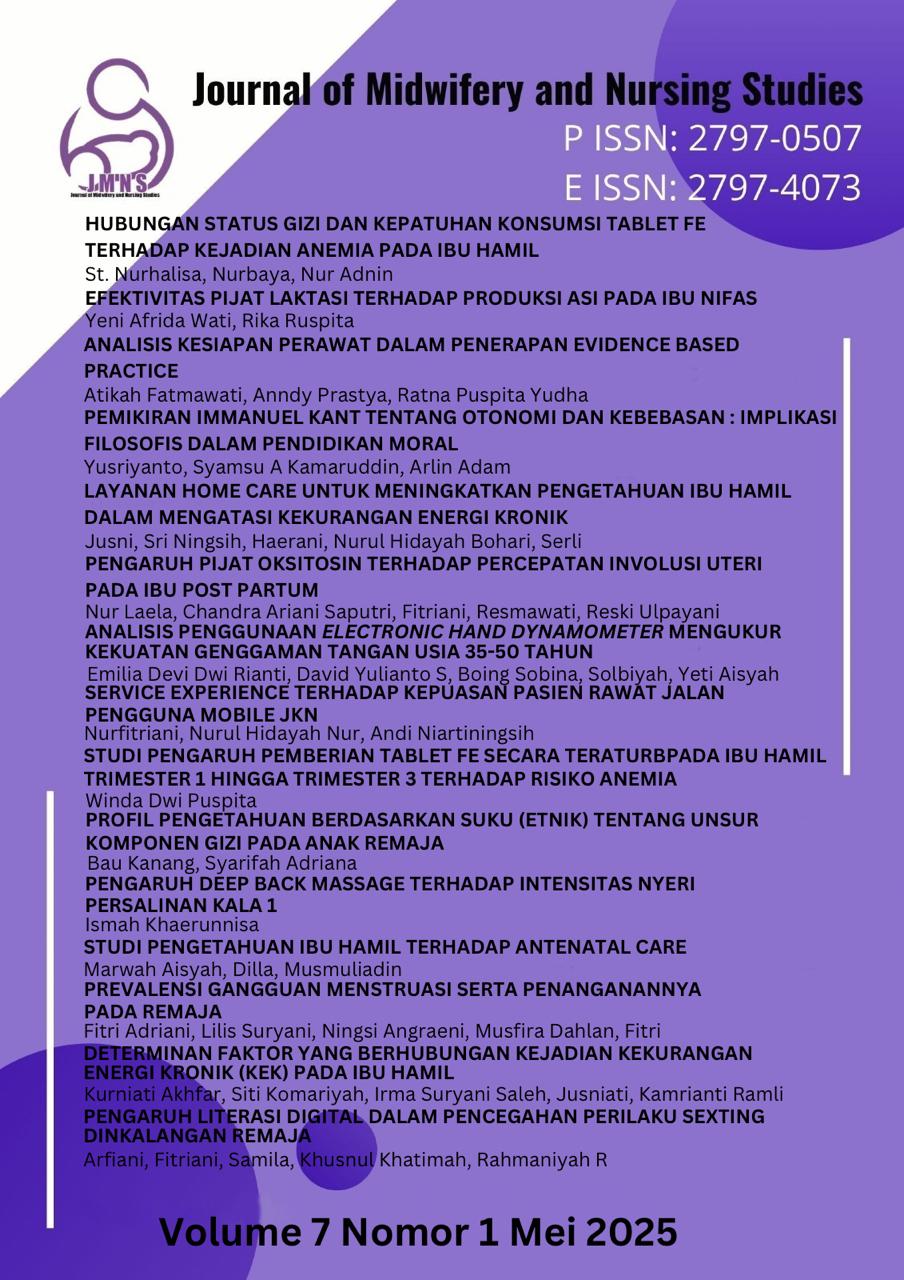PREVALENSI GANGGUAN MENSTRUASI SERTA PENANGANANNYA PADA REMAJA
Main Article Content
Abstract
Background: Indonesia as a developing country has a fairly large adolescent population. One of the changes in adolescent girls when they become adults is menstruation, but menstrual disorders are still a common problem with a fairly high incidence, especially in adolescents. As much as 75%. This can be serious if not treated immediately. Objective: to determine the prevalence of menstrual disorders and their treatment in adolescents, especially female students majoring in Midwifery at Almarisah Madani University. Method: This type of research is quantitative research with a descriptive design with a sample of 21 female students. Results: showed that most respondents (71%) experienced menstrual disorders, with details of 38% having abnormal cycles, 5% experiencing abnormal menstrual duration, and 57% experiencing dysmenorrhea. Meanwhile, amenorrhea was only experienced by 10% of respondents. Menstrual disorders found included polymenorrhea, oligomenorrhea, hypomenorrhea, hypermenorrhea, dysmenorrhea, and amenorrhea. This disorder not only affects physical health, but can also affect the psychological condition and quality of life of adolescents, and has the potential to cause long-term health problems such as infertility. Treatment for adolescents is generally non-pharmacological, including warm water compresses, rest, stress management, improving diet and sleep patterns, and taking painkillers independently.
Article Details

This work is licensed under a Creative Commons Attribution-NonCommercial 4.0 International License.
All right reserved. The articles in this journal are under copyright of JMNS and the author of the article. No part of the articles may be reproduced without permission of the journal management
References
Aswatun, H. N. (2020). Efektivitas Kompres Hangat untuk Menurunkan Tingkat Nyeri terhadap Klien DismenoreaPrimer.
Jusni dan Arfiani. (2022). Kesehatan Perempuan Dan Perncanaan Keluarga. Mitra Cendekia Media.
Jusni, dkk. (2024). Pengaruh Pijat Endorphine Terhadap Penurunan Nyeri Dismenorhea Di Kabupaten Bulukumba: A Quasy-Experiment Study. Jurnal JMNS. https://doi.org/10.57170/jmns.v6i2.136
Jusni, Erniawati, Nurul Hidayah Bohari, Husnul Khatimah, Sumarni, Kurniati Akhfar, Arfiani, S. K. (2023). Layanan Home Care untuk Mengatasi Ketidaknyaman Wanita. In Penerbit Cendekia Medika.
Larasati, S. S., & Soputri, N. (2023). Hubungan Kualitas Tidur Dengan Dismenorea Primer Pada Mahasiswi Keperawatan Di Universitas Advent Indonesia. Jurnal Ilmiah Obsgin, 15(2018), 584–593. https://stikes-nhm.e-journal.id/OBJ/index%0AArticle
Miraturrofi’ah, M. (2020). Kejadian Gangguan Menstruasi Berdasarkan Status Gizi Pada Remaja. Jurnal Asuhan Ibu Dan Anak, 5(2), 31–42. https://doi.org/10.33867/jaia.v5i2.191
Prayuni, E. D., Imandiri, A., & Adianti, M. (2019). Therapy for Irregular Menstruation With Acupunture and Herbal Pegagan (Centella Asiatica (L.)). Journal Of Vocational Health Studies, 2(2), 86. https://doi.org/10.20473/jvhs.v2.i2.2018.86-91
Sonata, M. P., & Sianipar, I. M. (2023). Hubungan Stres Kerja dengan Gangguan Siklus Menstruasi pada Perawat di Rumah Sakit. Jurnal Ilmiah Permas: Jurnal Ilmiah STIKES Kendal, 13(1 SE-article), 329–336.
Yusrah Taqiyah, Fatma Jama, N. (2017). Analisis Faktor yang Berhubungan dengan Kejadian Dismenorhea. Jurnal Kesehatan, 8(1), 41. https://doi.org/10.26630/jk.v8i1.392
Zahra, M. A., Aisyiah, A., & Nurani, I. A. (2023). Analisis Faktor-Faktor Yang Berhubungan Dengan Siklus Menstruasi Pada Siswi Di Smk It Raflesia Depok. Jurnal Keperawatan Widya Gantari Indonesia, 7(1), 7–17. https://doi.org/10.52020/jkwgi.v7i1.5469.
